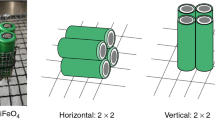Abstract
In order to investigate the thermal runaway mechanism of 18650 lithium ion batteries and the related hazards, an experimental platform for lithium ion battery fire and explosion is designed and built. The effects of different arrangements, including vertical 2 × 2 and vertical 4 × 1, and initial pressure (96 kPa and 61 kPa) on lithium ion battery thermal runaway are studied in this paper. Compared with the results of thermal runaway characteristics with two arrangements, a higher explosion pressure, a larger mass loss, more O2 consumption and more CO and CO2 production are observed of vertical 2 × 2 batteries due to the larger contact area between batteries. The explosion pressure of vertical 4 × 1 batteries decreases gradually with thermal runaway propagation. For vertical 2 × 2 batteries, the explosion pressure of battery C, D is about twice as large as battery A. The intensity of chemical reaction is more violent under 96 kPa which cause a lower onset temperature and a shorter onset time than that under 61 kPa. The thermal runaway propagation hazard can be reduced by decreasing the contact area between batteries. The results could provide useful guidance for the safety of lithium ion battery transportation in civil aviation.








Similar content being viewed by others
References
Lisbona D, Snee T (2011) A review of hazards associated with primary lithium and lithium-ion batteries. Process Saf Environ Prot 89:434–442
Arbizzani C, Gabrielli G, Mastragostino M (2011) Thermal stability and flammability of electrolytes for lithium-ion batteries. J Power Sources 196:4801–4805
FAA (2019) Aviation cargo and passenger baggage events involving smoke, fire, extreme heat or explosion involving lithium batteries or unknown battery types. FAA Office of Security and Hazardous Materials Safety
Chen M, Sun QJ, Li YQ, Wu K, Liu BJ, Peng P, Wang QS (2015) A thermal runaway simulation on a lithium titanate battery and the battery module. Energies 8:490–500
Feng XN, Sun J, Ouyang MG, Wang F, He XM, Lu L, Peng H (2015) Characterization of penetration induced thermal runaway propagation process within a large format lithium ion battery module. J Power Sources 275:261–273
Zhang QS, Guo CC, Qin SX (2016) Study on lithium-ion batteries explosive characteristics and aviation transportation safety. China Saf Sci J 26:50–55
Hu QW (2015) Study on lithium-ion batteries thermal runaway propagation characteristics and blocking techniques. Dissertation, China Ship Research and Development Academy
Sun Q (2018) The study of lithium-ion batteries fire propagation characteristics in a low-pressure environment. Dissertation, Civil Aviation Flight University of China
Roth EP, Doughty DH (2004) Thermal abuse performance of high-power 18650 Li-ion batterys. Power Sources 128:308–318
Roth EP, Doughty DH, Franklin J (2004) DSC investigation of exothermic reactions occurring at elevated temperatures in lithium ion anodes containing PVDF-based binders. Power Sources 134:222–234
Gao F, Yang K, Li DH (2015) Evaluation of combustibility of lithium ion battery components and dangers they involve. China Saf Sci J 25:62–67
Li K (2016) Study on electrochemical thermal analysis and finite element modelling for lithium ion power battery. Dissertation, School of Materials Science and Engineering
Song LB (2013) The thermo-electrochemical study on lithium ion batteries and numerical calculation and simulation of electrode material in lithium ion batteries. Dissertation, Central South University
Peng M, Shen WJ, Luo ZD (2018) Two-dimensional thermal modeling for laminated lithium ion battery. Chinese J Power Sources 42:1312–1315
Xiao Y, Gong CZ, Zhang HL (2018) Modeling of power lithium ion battery based on Simulink. Automob Technol 22:14–16
Liu L, Bao SS, He H, Sun WX, Yue B, Li JF (2017) Research progress of Ni-rich ternary cathode materials for lithium ion batteries. Electron Comp Mater 36:58–65
Liu YC (2019) Study on material modification of lithium ion battery ternary anode material (NCM). Mod Chem Res 3:55–57
Jiang SS (2018) Study on preparation and properties of polytriphenylamine as cathode material for lithium ion batteries. World Nonferrous Metal 23:154–155
Huang JF, Wu WC, Li JY, Cao LY, Zhou L, Li QY, He YY, Liu QQ (2019) Synthesis and electrochemical properties of Nb2O5 with different crystal type as cathode material for lithium ion batteries. J Shaanxi Univ Sci 37:89–94
Marco R, Patricia W (2019) Prospective LCA of the production and EOL recycling of a novel type of Li-ion battery for electric vehicles. J Clean Prod 213:926–932
Bai FF, Song WJ, Chen MB, Feng ZP (2016) Statues quo of research on Li-ion battery thermal management system. Battery 46:168–171
Deng ZB, Sun Q, He YH (2018) Experimental study on the trigger conditions of 18650 type lithium-ion battery thermal runaway fire extension. Fire Sci Technol 37:690–693
Zhang QS, Jiang NW, Luo XN, Cao WJ (2016) Lithium-ion battery thermal runaway domino effect experimental verification research. Sci Technol Eng 16:252–256
Cai L, White RE (2011) Mathematical modeling of a lithium ion battery with thermal effects in COMSOL Inc. Multiphysics (MP) software. J Power Sour 196:5985–5989
Gu CH (2017) HCN distribution and smoke toxicity analysis of fire smoke in a sofa workshop based on N-Gas model. J Inst Disast Prev 19:66–73
Li SL, Jiang Y, Qiu R, Chen SS (2012) Fire smoke toxicity quantative evaluation model THVCH and application. J Saf Environ 12:250–256
Funding
Funding was provided by National Natural Science Foundation of China (Grant Nos. U1633203, U1733126).
Author information
Authors and Affiliations
Corresponding author
Additional information
Publisher's Note
Springer Nature remains neutral with regard to jurisdictional claims in published maps and institutional affiliations.
Rights and permissions
About this article
Cite this article
Quanyi, L., Xiaoying, Y. & Xu, H. Effect of Different Arrangement on Thermal Runaway Characteristics of 18650 Lithium Ion Batteries Under the Typical Pressure in Civil Aviation Transportation. Fire Technol 56, 2509–2523 (2020). https://doi.org/10.1007/s10694-020-00984-0
Received:
Accepted:
Published:
Issue Date:
DOI: https://doi.org/10.1007/s10694-020-00984-0




